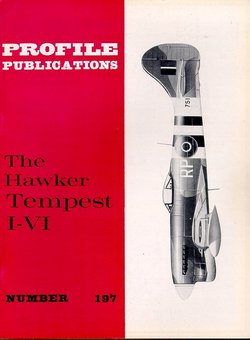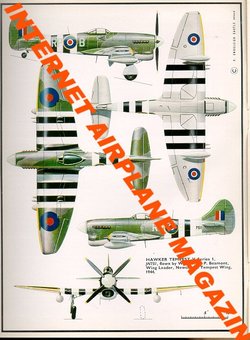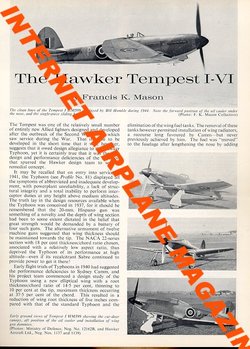RARE & HARD TO FIND. READY TO
COMPLETE YOUR COLLECTION. FILL IN THE GAPS! NOTE- AUCTION PROTECTION
WATERMARKING ON THESE IMAGES ATTACHED TO THIS AUCTION DO NOT APPEAR ON AUCTUAL
PUBLICATION.
THIS IS A 20-PAGE SOFTBOUND
BOOKLET FROM THE PROFILE PUBLICATIONS SERIES PUBLISHED IN THE SIXTIES
CONTAINING B/W PHOTOGRAPHS, 2-PAGES OF COLOR PROFILES / COLOR THREE VIEW SCALE
DRAWINGS CENTERFOLD, TECHNICAL SPECIFICATIONS, DETAILS OF DEVELOPMENT AND
OPERATIONAL USE. THIS IS A CLASSIC REFERENCE BOOK ON THE SUBJECT AIRCRAFT IT IS
NOT A PLASTIC MODEL KIT. IT IS ALSO NOT ONE OF THE ILLEGAL AND POOR QUALITY
SCANNED COPIES OF THIS HARD-TO-FIND BOOKLET NOW APPEARING ON EBAY. PUBLISHED IN
ENGLAND UK BY PROFILE PUBLICATIONS LIMITED. IT DOES NOT HAVE HOLES PUNCHED IN IT.
YOU WILL FIND GREAT DEALS ON
HARD-TO-FIND AVIATION, ARMOR, NAUTICAL AND MILITARIA MAGAZINES AT MY EBAY STORE
“INTERNET AIRPLANE MAGAZINES AND BOOKS”!
I HAVE HUNDREDS OF ADDITIONAL
LISTINGS USING THE SIMPLE “BUY-IT-NOW” FORMAT. I SPECIALIZE IN AVIATION
REFERENCE MAGAZINES AND BOOKS. I ALSO CARRY TITLES ON MILITARY HISTORY, ARMOR,
TANKS, SHIPS, ELITE SPECIAL UNITS AND AMERICAN CIVIL WAR. THESE ARE EXCELLENT
GIFTS & REFERENCES FOR PILOTS, MILITARY AIRCREW, VETERANS, MILITARY
RE-ENACTORS, SCALE MODELERS & AIRCRAFT ENTHUSIASTS. TITLES CURRENTLY LISTED
INCLUDED: THE ELITE, TAKE OFF, WARPLANE, PROFILE PUBLICATIONS, AIRCRAFT
ILLUSTRATED, AIRCRAFT ILLUSTRATED EXTRA, AIR COMBAT, AIR ENTHUSIAST, AMERICAN
AIRMAN AND THE ILLUSTRATED ENCYCLOPEDIA OF AIRCRAFT.
HARD TO FIND GIFTS FOR SCALE
MODELERS, PILOTS, AIRCREW & VETERANS
HERE'S AN INEXPENSIVE FATHER'S
DAY GIFT, BIRTHDAY PRESENT OR CHRISTMAS PRESENT FOR THE VETERAN, REENACTOR,
SCALE MODELER, MILITARIA ENTHUSIAST OR HISTORY CHANNEL LOVER IN YOUR FAMILY
PAYMENT INSTRUCTIONS:
AFTER THE AUCTION HAS COMPLETED,
YOU WILL RECEIVE AN INVOICE FROM ME. PAYPAL ACCEPTED. ALL AUCTIONS MUST BE
COMPLETED WITHIN 10 DAYS. I WILL DO MY PART AND SHIP ASAP AFTER RECEIVING
PAYMENT (SEE MY FEEDBACK FILE).
MONEY BACK GUARANTEE!
YOU WILL LOVE MY CUSTOMER
FRIENDLY RETURN POLICY. I WANT YOU OR YOUR GIFT RECIPIENT TO BE HAPPY WITH YOUR
PURCHASE. I GUARANTEE THAT THE ITEM SHIPPED WILL BE AS DESCRIBED. YOU MAY
RETURN THE ITEM WITHIN 14 DAYS FOR ANY REASON. JUST EMAIL ME AND RETURN POST
THE PACKAGE ADEQUATELY PROTECTED AGAINST SHIPPING DAMAGE) AND I WILL RETURN
YOUR ITEM PURCHASE PRICE IN FULL.
I WILL LEAVE POSITIVE FEEDBACK FOR YOU
I WILL POST POSITIVE FEEDBACK FOR
YOU AFTER THE TRANSACTION IS COMPLETE AND I AM REASONABLY SURE THAT YOU HAVE
RECEIVED THE ITEM. IF THERE IS ANY PROBLEM, PLEASE EMAIL ME TO WORK THINGS OUT
BEFORE LEAVING FEEDBACK. MY GOAL IS TO LEAVE EVERY CUSTOMER 100% SATISFIED WITH
MY PRODUCTS AND SERVICE.
-------------------------------------------------------------------------------------------------------------------
Additional Information from Internet Encyclopedia
The Hawker Tempest was a British fighter aircraft
primarily used by the Royal Air Force (RAF) in the Second World War. The
Tempest was an improved derivative of the Hawker Typhoon, intended to address
problems with the Typhoon's unexpected low performance by replacing its wing
with a much thinner laminar flow design. It emerged as one of the most powerful
fighters used during the war.
During development of the Typhoon the design team, under
the leadership of Sydney Camm, were already planning design improvements, this
process resulting in the Hawker P. 1012 (or Typhoon II). Although the Typhoon
was generally a good design, Camm and his design team were disappointed with
the wing, which proved to be too thick in its cross section. This created
airflow problems and inhibited flight performance, especially at higher
altitudes and speeds. The Typhoon's wing, using a NACA 4 digit series wing
section, had a maximum thickness to chord ratio of 19.5% (root) to 12% (tip),
in comparison to the Supermarine Spitfire's 13.2% tapering to 6% at the tip,
the thinner design deliberately chosen to reduce drag.
In March 1940, engineers were assigned to investigate the
new low drag laminar flow wing developed by NACA in the United States, which
had been used in the new North American P-51 Mustang. A laminar flow wing
adopted for the Tempest series had a maximum thickness to chord ratio of 14.5%
at the root, tapering to 10% at the tip. The maximum thickness of the Tempest
wing was set further back at 37.5% of the chord versus 30% for the Typhoon's
wing.
The wingspan was originally greater than that of the
Typhoon at 43 ft (13.1 m), but the wingtips were later "clipped" and
the wing became shorter; 41 ft (12.5 m) versus 41 ft 7 in (12.7 m). The wing
planform was changed to an elliptical shape to accommodate the 800 rounds of
ammunition for the four 20 mm Hispano cannons, which were moved back further
into the wing. The new elliptical wing had greater area than the Typhoon's.
However, the new wing design sacrificed the leading edge fuel tanks of the
Typhoon: to make up for this loss in capacity, Hawker engineers added a new 21
in (53 cm) fuel bay in front of the cockpit, with a 76 gl (345 l) fuel tank. In
addition, two inter-spar wing tanks, each of 28 gal (127 l), were fitted on either
side of the centre-section and, starting with late model Tempest Vs, a 30 gal
(136 l) tank was carried in the leading edge of the port wingroot, giving the
Tempest a total internal fuel capacity of 162 gal (736 l).
In service, Tempests also carried two specially designed,
streamlined, drop tanks of 45 gal (204 l) giving a maximum of 360 gal (1,636 l)
and an operational radius of 500 mi (805 km) Another important feature of the
new wing was Camm's proposal that radiators for the new Napier Sabre IV engine
be fitted into the leading edge of the wing inboard of the undercarriage. This
eliminated the distinctive "chin" radiator of the Typhoon and
improved aerodynamics. A further improvement of the Tempest wing over that of
the Typhoon was the exceptional, flush-riveted surface finish, essential on a
high performance laminar flow airfoil. The new wing and airfoil, and the
four-bladed propeller, eliminated the high frequency vibrations that had
plagued the Typhoon.
The redesigned main undercarriage legs were longer and
had a wider track (16 ft/5 m) to improve stability at the high landing speed of
110 mph (180 km/h), and to allow tip clearance for a new de Havilland 14 ft (4
m) diameter four-blade propeller. The main undercarriage units were Dowty
levered suspension units incorporating trunnions which shortened the legs as
they retracted. The majority of the Tempests built used 30 by 9 inch (76.2 by
22.9 cm) four-spoke wheels, while the prototypes and early production Tempest
Vs used the Typhoon's larger 34 by 11 inch (83.4 by 28 cm) five-spoke wheels.
The retractable tailwheel was fully enclosed by small doors and could be fitted
with either a plain Dunlop manufactured tyre, or a Dunlop-Marstrand
"twin-contact" anti-shimmy tyre.
Camm and the Hawker design team placed a high priority on
making their aircraft easily accessible to both air and ground crews; to this
end the forward fuselage and cockpit areas of the earlier Hurricane and the
Tempest and Typhoon families were covered by large removable panels providing
access to as many components as possible, including flight controls and engine
accessories. Both upper wing roots incorporated panels of non-slip coating. For
the pilot a retractable foot stirrup under the starboard root trailing edge was
linked to a pair of handholds which were covered by spring-loaded flaps.
Through a system of linkages, when the canopy was open the stirrup was lowered
and the flaps opened, providing easy access to the cockpit. As the canopy was
closed the stirrup was raised into the fuselage and the flaps snapped shut.
The Tempest V was in the hands of operational squadrons
by April 1944; 3 Squadron was the first to be fully equipped, closely followed
by 486 (NZ) Squadron (the only Article XV unit to be equipped with the Tempest
during the Second World War). A third unit—56 Squadron—initially kept its
Typhoons and was then temporarily equipped with Spitfire IXs until sufficient
supplies of Tempests were available. By the end of April 1944, these units were
based at RAF Newchurch a new "Advanced Landing Ground" (ALG), where
they formed 150 Wing, commanded by Wing Commander Roland Beamont. The new Wing
was part of the Second Tactical Air Force (2nd TAF).
Most of the operations carried out by 150 Wing comprised
high-altitude fighter sweeps, offensive operations known as "Rangers"
(long-range sorties inside enemy territory, specifically to attack ground
vehicles) and anti-shipping reconnaissance. In June 1944, however, the first
German V-1 flying bombs were launched against London and the Tempest's
excellent low-altitude performance made it one of the preferred tools for
dealing with the small fast-flying unmanned missiles. 150 Wing was transferred
back to the ADGB, where the Tempest squadrons racked up a considerable
percentage of the total RAF kills over the flying bombs (638 of a total of
1,846 destroyed by aircraft).
In September 1944, Tempest units, based at forward
airfields in England, supported Operation Market Garden, the Airborne attempt
to seize a bridgehead over the Rhine. On 21 September 1944, as the V1 threat
had receded, the Tempest squadrons were redeployed to the 2nd TAF, effectively
trading places with the Mustang III squadrons of 122 Wing, which became part of
the ADGB units deployed on bomber escort duties. 122 Wing now consisted of 3
Sqn., 56 Sqn., 80 Sqn., 274 Sqn (to March 1945), and 486(NZ)Sqn. From 1 October
1944 122 Wing was based at B.80 Volkel Air Base near Uden, in the Netherlands.
In February 1945 33 and 222 Sqns. of 135 Wing converted from Spitfire Mk IXs
and, in March, were joined by 274 Sqn. 135 Wing was based at B.77 Gilze-Rijen
airfield in the Netherlands.
The Tempest's primary role was to carry out "armed
reconnaissance" operations deep behind enemy front lines. The Tempest was
particularly well suited to the role because of its high speed at low to medium
altitudes, its long range when equipped with two 45-gallon drop tanks, the good
firepower of the four 20mm cannon and the good pilot visibility. Armed
reconnaissance missions were usually flown by two sections (eight aircraft),
flying in Finger-four formations, which would cross the front lines at
altitudes of 7,000 to 8,000 feet: once the Tempests reached their allocated
target area the lead section dropped to 4,000 feet or lower to search for
targets to strafe, while the other section flew cover 1,000 feet higher and
down sun. After the first section had carried out several attacks it would swap
places with the second section and the attacks would continue until ammunition
had been exhausted, after which the Tempests would return to base at 8,000 ft.
Because the most profitable targets were usually some 250 miles from base, the
Tempests usually carried two 45-gallon drop tanks which were turned on soon
after takeoff. Although there were fears that the empty tanks would explode if
hit by flak, the threat never eventuated and, because they could be difficult
to jettison, they were routinely carried throughout an operation with little
effect on performance, reducing maximum speed by 5 to 10 mph and range by 2%.
In December 1944, 52 German fighters were downed and 89
trains destroyed, for the loss of 20 Tempests. Following the Luftwaffež 's
Operation Bodenplatte of 1 January 1945, 122 Wing bore the brunt of low- to
medium-altitude fighter operations for the Second Tactical Air Force. Spitfire
XIVs of 125 and 126 Wings often provided medium- to high-altitude cover for the
Tempests. The Wing came under intense pressure, losing 47 pilots in January.
Tempests also scored a number of kills against the new
German jets, including the Messerschmitt Me 262. Hubert Lange, a Me 262 pilot,
said: "the Messerschmitt Me 262's most dangerous opponent was the British
Hawker Tempest — extremely fast at low altitudes, highly-manoeuvrable and heavily-armed."
Some were destroyed with a tactic known to 135 Wing as the "Rat
Scramble": Tempests on immediate alert took off when an Me 262 was
reported to be airborne. They did not intercept the jet, but instead flew
towards the Me 262 and Ar 234 base at Rheine-Hopsten. The aim was to attack
jets on their landing approach, when they were at their most vulnerable,
travelling slowly, with flaps down and incapable of rapid acceleration. The
Germans responded by creating a "flak lane" of over 150 of the dreaded
Flakvierling "quadmount" 20 mm (.79 in) AA batteries at
Rheine-Hopsten, to protect the approaches. After seven Tempests were lost to
flak at Rheine-Hopsten in a single week, the "Rat Scramble" was
discontinued. For a while, in March 1945, a strict "No, repeat, No ground
attacks" policy was imposed; this only applied for a few days.
In air-to-air combat, the Tempest units achieved an
estimated air combat success ratio of 7:1, accomplishing a 6:1 ratio against
single-seat enemy fighters. The top-scoring Tempest pilot was Squadron Leader
David C. "Foobs" Fairbanks DFC, an American who joined the Royal
Canadian Air Force in 1941. By mid-1944, he was flying with 274 Squadron. When
he was shot down and made a POW in February 1945, he had destroyed 11 or 12 German
aircraft (and one shared), to make him the highest-scoring Tempest ace.







